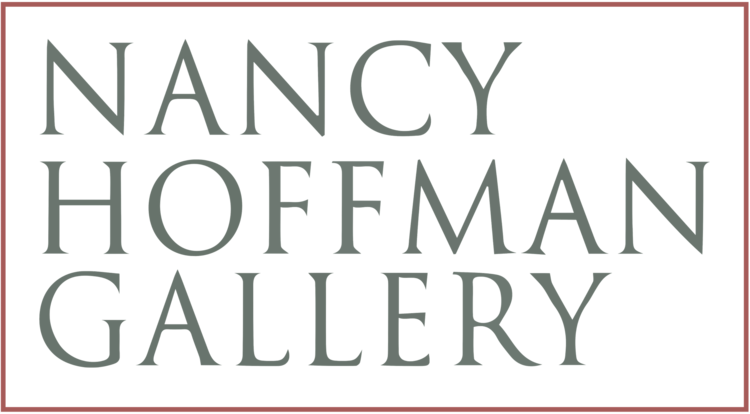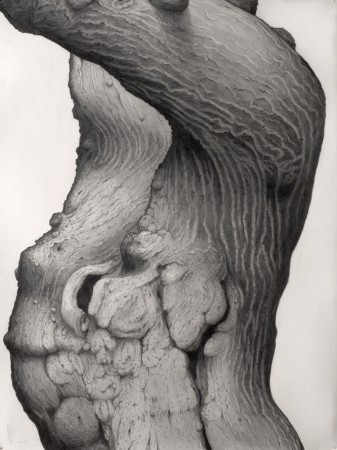Jim Sullivan
May 26 - July 1, 2011
The next exhibition at Nancy Hoffman Gallery will be new graphite drawings of trees by Jim Sullivan, opening on May 26th and continuing through July 1st. This is the artist’s first solo show in six years, and reveals a new vista onto nature.
His last show included a series of horizontal landscapes, wide cinematic views into invented detailed oriented oils. The artist delighted in painting myriad details. These were obsessive paintings, and as the artist says: “The new drawings, the work of the past five years, present the same viewing issues as the long landscapes, in that they have normal viewing distance but offer a close scrutinizing experience (of infinite detail) on closer examination.”
Sullivan’s trees are not conventional; the drawings are close-in, mesmerizingly intense sections of trunks, abstracted from the tree. In most, there is no top filled with branches and no bottom with roots reaching into earth. The trunks stand alone as vertical soldiers in procession. The graphite drawings are real and abstract at the same time. They are gray, black and white, silvery, bulbous, craggy and scaly, with hidden passages. His subject comes from a deep love of nature that surrounds him in up-state New York, where he builds rock walls, hauling huge rocks himself from the surrounding terrain,
in the midst of ancient tree-filled woods. In the art historical tradition of painters who dared to reveal warts, bumps, lines and facial lumps, Sullivan tells and invents it all. Sullivan says:
“The source for these trees is from photos I've taken of trees in Switzerland, Washington Square Park, Greenwood Cemetery; Venice, California and mostly from Jefferson, New York. Sometimes two or three trees are combined and at other times they're completely invented. I choose venerable trees with the scars and heft of age [like me].”
He says of the new works:
“I believe that some of the power in these drawings comes from the fact that they're rendered realistically, even photographically, but they are at the same time surreal, even fairytale-ish of the old scary English and German variety. People try to figure out what they're looking at--in most cases, pleasantly confounded. They are trees-- really? There is also the strangeness of their anthropomorphic qualities, sometimes sexual, sometimes strangely humorous, in spite of their dark, heavy, spooky, presences. The size, degree of finish and minute precision of details help them appear more convincing. They take many hours to do, burning through five, six or more Staedtler 3B pencils each. I am sometimes amazed to look at this work with a pencil in my hand, to enforce the realization of how small and insignificant a pencil really is. I am also aware of the significance of trees to my Celtic heritage. These were objects of deep veneration in pre-Christian Ireland. Their spiritual force is understandable when one considers that we're looking at the tallest living things on earth.”
Included in the show is one full tree with a filigree of silvery branches that reach up 90 inches in height and a slender trunk floating above the earth, a tree that “grew like topsy” as the artist worked over several pieces of paper to create a gossamer drawing as a complement to the bold trunks. The large full tree contextualizes all of Sullivan’s trunks. He says of this work: “The big tree is totally invented, in fact I grew it--literally starting with a trunk and letting it grow until it, the tree, determined the ultimate size of the drawing, needing to be completed on a ladder.”
Sullivan’s gesture ranges from bold to filigree, from obsessive to free, and transforms one’s gaze at and perception of trees, by revealing to the viewer what the eye never takes time to contemplate in nature.
Jim Sullivan was born in Providence, Rhode Island in 1939. He received a Bachelor of Fine Arts from Rhode Island School of Design with a European Honors Program in Rome and graduate work at Stanford University, California. He is the recipient of a National Endowment for the Arts grant in painting; American Academy of Arts and Letters Award in Painting; a Guggenheim Fellowship in Painting and a Fulbright Fellowship in Painting in Paris.
His work has been shown at Aldrich Museum of Contemporary Art, Ridgefield, Connecticut; American Academy of Arts and Letters, New York; Arkansas Arts Center, Little Rock; Baltimore Museum of Art, Maryland; Center for the Arts, Vero Beach, Florida; Chicago Public Library and Cultural Center; Contemporary Arts Center, Cincinnati; Corcoran Gallery of Art, Washington, D.C.; DeCordova Museum, Lincoln, Massachusetts; Delaware Art Museum, Wilmington; The High Museum of Art, Atlanta, Georgia; Indianapolis Museum of Art, Indiana; Madison Art Center, Wisconsin; McNay Art Museum, San Antonio, Texas; Museum of Art and History, San Juan, Puerto Rico; Museum of Contemporary Art, Chicago; Museum of Fine Arts, Houston, Texas; Museum of Modern Art, New York; New York Public Library, New York; New York State Museum, Albany; Norton Gallery, West Palm Beach, Florida; Oakland Museum, California; Oklahoma Art Center, Oklahoma City; Polk Museum of Art, Lakeland, Florida; , Queens Museum, New York; Utah Museum of Fine Arts, Salt Lake City; Whitney Museum of American Art, New York; Worcester Art Museum, Massachusetts.
The artist’s work is included in the collections of Albany State Museum, New York; The Aldrich Museum of Contemporary Art, Ridgefield, Connecticut; American Institute of Architects, Washington, D.C.; The Metropolitan Museum of Art, New York; Miami Dade Junior College, Miami, Florida; University of North Carolina, Chapel Hill; Owens Corning College, Toledo, Ohio; Wadsworth Atheneum, Hartford, Connecticut; Whitney Museum of American Art, New York; Worcester Art Museum, Massachusetts.
Sullivan has also lectured extensively as visiting artist at colleges and universities in graduate and undergraduate programs.
For further information and/or photographs please call 212-966-6676 or email Nancy Hoffman Gallery at info@nancyhoffmangallery.com
Yours sincerely,
Nancy Hoffman













